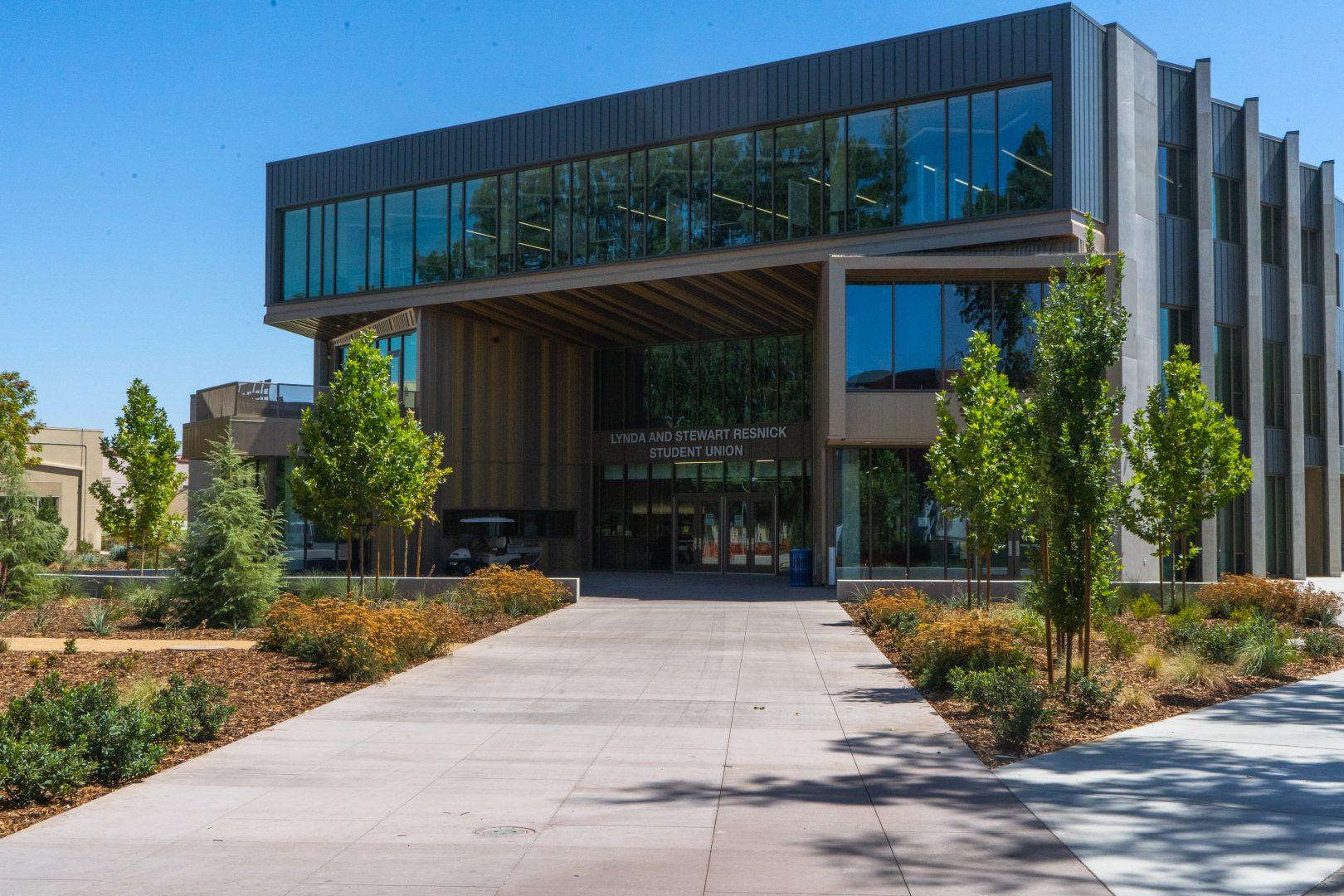Fresno State students will be paying off the RSU for next 30 years
The front of the Resnick Student Union (RSU) at Fresno State.
Nov 29, 2022
Fresno State students will be paying off the Resnick Student Union (RSU) for the next three decades as student fees increase each year, starting this spring.
The $149 RSU fee accompanied by a 3% annual increase goes toward operation costs and paying off the RSU. The bond will be paid off in 30 years.
Students voted to approve an increase in student fees to fund the RSU in 2018.
Since October, The Collegian researched the RSU budget through a series of back-and-forth emails with University Communications; a Public Records Act request; and eventually a sit-down interview with Debbie Adishian-Astone, vice president for administration and chief financial officer, in November.
According to the documents obtained by The Collegian, the maximum annual debt service fee to pay off the debt was initially estimated at approximately $3.7 million in September 2019, but because the CSU obtained a lower interest rate, the fee is now approximately $2.6 million.
Despite the annual payment dropping by over $1 million, the $149 RSU fee did not change.
Adishian-Astone said the amount couldn’t be adjusted for the term of the bond.
“But it would absolutely be something that can be looked at once the debt is retired,” she said.
In the spring 2023 semester, students will pay $384 in student union fees, including: a prorated fee of $114 for a fall 2022 RSU fee, the $149 spring RSU fee and the $121 student union fee. The fall prorated fee will only apply in the spring 2023 semester.
Following this, the RSU fee of $149 per semester with an annual 3% increase will be permanently added to the $121 student union fee after the spring, as approved by 67% of student voters in the 2018 fee referendum.
A plaque in the RSU notes that the student voters “came together to leave this legacy.”

In 2022-23, students will pay $263 for RSU fees, which includes the $149 base fee and the prorated
$114 for fall 2022. After spring 2023, the 3% annual increase will be in effect. By 2051, the RSU fee will
total approximately $706 for the academic year. (Graphic by Wyatt Bible/The Collegian)
When students voted in 2018, it was emphasized in the ballot language that this fee increase would not be implemented until the building opened in four to five years, but no mention was made that the fee would continue even after 30 years when the building was paid off.
Many students who are new to Fresno State had not voted in this initial fee referendum, and are paying for this fee increase indefinitely.
“Most students are going to probably have a rude awakening. All of a sudden their student fees have increased. Why? How? Who said that was OK? Well, students back in 2018 said it was OK,” said Thomas Holyoke, Fresno State political science professor.
Holyoke was a previous member of the Student Fee Advisory Committee during the time of the fee referendum’s approval and told The Collegian that the decision was “arguably not fair.”
“The students who voted to do this did not have to pay the fee. The students who have to pay the fee had no voice in deciding it,” he said.
Adishian-Astone said that this increase was ultimately voted on and approved by students, and that the administration did not make the decision to implement the fee increase. She emphasized that the fee increase was an investment by students to replace an outdated University Student Union.
“We delivered on what the students wanted, and I think we did it in a very cost-efficient way,” she said.
The total projected project cost of the RSU is $60 million, according to Fresno State financial documents obtained by The Collegian.
Because the CSU system requires a 10% contribution of the total projected cost for projects of this size, Fresno State paid $6 million toward the RSU: $4 million from Student Union campus reserves and $2 million from the $10 million donor funds pledged by the Resnick Foundation.
“Fortunately, we had that. Because over the years, we’ve been saving knowing that, eventually, this was a project that was going to be moved forward and knowing that we’d have to be able to save for that down payment, which pretty much exhausted the State Trust Fund balance,” Adishian-Astone said.
Approximately $54 million was financed for the RSU through the issuance of “two separate tax-exempt commercial paper (CP) notes/BANS and Systemwide Revenue Bonds (SRB) as authorized by the CSU Board of Trustees,” wrote Rosa H. Renaud, director of long term finance for the CSU, in a letter to Adishian-Astone regarding the debt service schedule on Oct. 9, 2020.
This year, the university will see a loss of approximately $840,000 in student union fees as the fall RSU fee was prorated due to the delayed opening of the building, Adishian-Astone said.
In a typical year with an estimated enrollment of 24,000 students, the annual revenue with the $149 RSU fee per semester is approximately $7.1 million. Of this, approximately $2.6 million will go toward the debt service fee; $2.8 million for the estimated annual operating budget; and $1 million to the capital repair and replacement reserve.
The remaining surplus of approximately $652,367 will go toward the State Trust Account in a typical academic year to “replenish operating reserves that were used for [the] down payment, milestone Change Order and one year of operating budget on deposit,” according to documents provided by Adishian-Astone.
This amount will vary based on enrollment and the 3% annual increase to RSU fees.
Although debt service amounts will remain relatively level, operating costs will fluctuate each year, according to Adishian-Astone.
“We’ve got minimum wage, we’ve got utility costs. The budget that we did this year for the RSU, it was an estimate. We won’t know until June 30 if we hit the mark or not. We could hit it. We could not hit it,” she said.
If the university hadn’t gotten a lower interest rate and If the debt service amount were any higher, Adishian-Astone said the university would not be running a deficit. Instead, it would have had to adjust or reduce the capital reserved contribution amount and potentially the operating budget.
The RSU Fee breakdown notes that “the Chancellor’s Office requires revenues in excess of debt service by at least 1.25% for student union project financings.”
“All of this stays within student fees. So, it’s all accounted for as part of whatever the needs are for any of our student unions. It could be the Resnick Student Union, it could be the existing [University] Student Union, could be the Satellite [Student Union]. All of these fees go into one account,” Adishian-Astone said.
Fees in this account can also go toward the Student Recreation Center.
As the initial payments for the RSU came from the State Trust Fund and Local Auxiliary Reserve accounts, Adishian-Astone said the student fees will go toward rebuilding these accounts for the longevity of the RSU and other student union buildings.
In 2019-20, the State Trust Fund Account totaled approximately $5.2 million. In 2021-22, there was $3.6 million in the account. In 2022-23, it is projected to total $2.3 million.
“It is recommended that we have a healthy balance to take care of at least one year of operating and [this is] just best business practice,” Adishian-Astone said.
Funding in the reserves can go toward any major expense for student union buildings, she added.
Additionally, the Resnick Foundation’s remaining $1 million of the $4 million donated as of reporting remains in these accounts, earning interest, according to Adishian-Astone.







